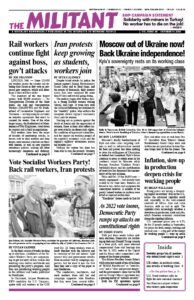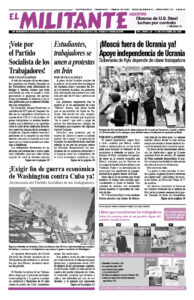LINCOLN, Neb. — Some 115,000 rail workers across the country are debating their future as they vote on proposed new contracts, which will determine if there will be a strike.
The members of the two largest unions, with 60,000 members — the Transportation Division of the Sheet Metal, Air, Rail and Transportation Workers (SMART-TD) and the Brotherhood of Locomotive Engineers and Trainmen — are beginning to cast votes on tentative agreements that won’t be counted for weeks. One of the other larger unions, the Brotherhood of Maintenance of Way Employees, voted down its contract and is back in negotiations.
Rail workers have been the target of decades of unrelenting attacks, as bosses seek to slash workers and heap longer, more onerous schedules on those who remain, as well as new punitive attendance policies, making rail labor increasingly dangerous and draining. Workers and their unions often call these “quality of life” issues.
As a result of this assault, the big rail bosses since 2015 have raked in $146 billion in profits off the backs of workers. And derailments and deaths on the job are up.
The 12 rail unions have been fighting to win improvements in negotiations with the National Carriers’ Conference Committee, which represents most Class 1 railroads and a number of short lines. They’ve been hampered by the anti-labor Railway Labor Act, which bars strikes until a long, drawn out government-monitored red-tape-laden process unfolds. The unions have set a strike deadline for December and say they’ll all go out if just one union rejects their agreement.
Two smaller craft unions announced Oct. 13 they had approved contracts. The Sheet Metal, Air, Rail Transportation Mechanical Department, which organizes 1,400 workers who maintain and rebuild locomotives, heating and ventilation systems, pipefitting and plumbing in the railroad shops, yards and buildings, voted to ratify by 54%. The National Conference of Firemen & Oilers, which organizes 2,400 workers who do the fueling and servicing of locomotives and shop maintenance, ratified by nearly 59%.
The presidents of both unions said the significant “no” vote expressed the concerns of workers on “quality of life” issues.
“I have been with the railroad for more than 14 years and work 70 to 80 hours a week,” NCFO member Eugene Martinez, who services locomotives for the Union Pacific in Houston, told a rail union survey. “When I was hired in 2008, we had close to 100 mechanical service operators. We are now down to 42. We’re taking on more work for the same pay.
“The job puts a lot of strain on our families,” he said, “because we miss a lot of events. We don’t really get those special meaningful times with our kids or our families. We miss birthdays, graduations, sporting events and more. … I speak for a lot of other workers who have missed time with their family. It shouldn’t be like this.”
One key question for the operating crafts is the bosses’ increasing push to get freight moving faster by cutting back on workers’ training.
Bosses push profits over safety
Jeremy Ferguson, president of SMART-TD, sent out a letter Oct. 14 warning the membership that “newly hired employees are receiving less than half of the standard training times that existed little more than a year ago.” He says this “is unacceptable and a danger to us all.”
Ferguson adds, “A carrier should never task a recently promoted conductor” with less than 12 months of service “with the training of another new hire employee.” This “has resulted in injuries and fatalities in the past and we cannot allow it to continue.”
He says the unions need to take a greater role in control over training.
The fact is nearly 20 rail workers were killed and 6,000 injured every year for the last 25 years.
On Oct. 9, the New York Times ran a muckraking op-ed feature entitled, “Mismanagement and ‘Monster Trains’ Have Wrecked American Rail” by Justin Roczniak. He says, “Rail workers’ demands are not outrageous,” but that the current standoff is about much more — “the result of a deliberate half-century-long” boss campaign to boost profitability.
After World War II companies slashed trackage in hopes that focusing on fewer big-item industries would boost profits. Between 1950 and 2000, 79,300 railroad miles were abandoned. This meant the rail workforce was cut from some 1.5 million workers to slightly more than 500,000 in 1975. There are only 115,000 rail workers, trying to win a new contract today.
The rail bosses turned a big part of the freight industry over to trucking. And the trucking bosses were helped by deregulation and massive government investment in a new national highway network.
This meant profitability slumped, and by 1976 six major railroads went belly up. The bosses’ government stepped in to help. Under Presidents Richard Nixon, Gerald Ford and James Carter, Congress with bipartisan support passed the Regional Rail Reorganization Act of 1973, Railroad Revitalization and Regulatory Reform Act of 1976 and Staggers Rail Act in 1980. These laws led to a sweeping deregulation of the rail industry in the interest of the rail bosses.
The government played a decisive role in creating Conrail in 1976 out of six bankrupt railroads, pumping in more than $7 billion in federal subsidies. “Conrail cut costs everywhere it could,” Roczniak says. “The company was making strong profits by the ’80s and was reprivatized in 1987” — shoring up the empires of Norfolk Southern and CSX.
The rail bosses nationwide continued the assault on rail workers. The government also aided the Burlington Northern Santa Fe merger in 1995, followed by the acquisition by Union Pacific of Southern Pacific Railroad in 1996.
In the letter Ferguson wrote, he explains that after these steps, “Precision Scheduled Railroading (PSR) has devastated the rail industry.”
This profit-boosting scheme was introduced by bosses like Hunter Harrison at Canadian Pacific and later CSX, and copied virtually everywhere else. Under this banner the rail bosses further reduced the number of conductors, engineers and track and maintenance workers as a way to slash operating costs. Today they’re pushing to reduce the operating “crew” to just one person.
They run fewer, but far longer and heavier trains, pressing manufacturers and other shippers to have loads ready when they’re scheduled or face high late fees. They aim to move cars faster with fewer crews. And rail workers face arbitrary schedules, longer shifts, more fatigue and more work than before.
A capitalist government functions to guarantee profits for the bosses, facilitating their power to exploit workers’ labor. This is their job, not taking steps to developing the railroads — or any other industry — to advance the needs of society. For workers, union power and political independence from the state and the employer class becomes a precondition not only to take control over safety but to organize transportation to meet the needs of workers and farmers.
The Socialist Workers Party proposes our unions fight for no trains over 50 cars in length, with four-person crews — two workers on the locomotive and two workers on the rear of the train.

